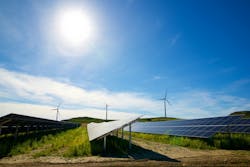Microsoft Signs 12-year Virtual PPA for Renewable Energy in Spain
Repsol, a Spanish energy and petrochemical company, and Microsoft have signed six 12-year virtual power purchase agreements (VPPAs) associated with three wind farms and three solar plants in Spain with a total installed capacity of 230 MW to be operational by December 2025.
The deal adds to existing power purchase agreements which are part of a partnership announced in 2021 with an overall installed capacity totaling 320 MW.
The strategic collaboration will focus on accelerating Repsol’s digital transformation and the global energy transition. The companies are co-innovating to build AI-powered digital solutions and Repsol provides Microsoft with renewable energy in Spain, as part of a long-term cooperation.
Repsol is also expanding its use of Microsoft cloud solutions to power its operations, including recommitting to the Azure cloud platform.
Repsol is expanding its renewable power business to reach between 9,000 MW and 10,000 MW of installed capacity by 2027, while Microsoft will source 100 percent of its energy supply from renewable energy by 2025.
"This agreement with Microsoft, a strategic partner, highlights the importance of renewable energy for the digital revolution in which we are deeply involved, and it also demonstrates Repsol's commitment to decarbonization," Joao Costeira, executive managing director of low carbon generation at Repsol, said in a statement.
Growth of AI and Data Centers Challenging Historic Power Equation
Brain Trust: Microgrid Industry Thinking Through Demand Crisis
Repsol will invest between $3.22 and $4.3 billion net in the development of its project portfolio through 2027 to achieve its growth objectives. Of the 9,000-10,000 MW to be installed, 50 percent will be in the Iberian Peninsula and 30 percent in the U.S., following the consolidation of the pipelines of Hecate and ConnectGen.
Additionally, Repsol plans to expand its presence in Chile and Italy, with a combined installed capacity of 1,500 MW in 2027.
Microsoft is taking many paths toward decarbonization as it pursues net zero emissions goals. Among these new energy technologies include a project with Caterpillar utilizing hydrogen fuel cells to power the company's data center in Wyoming, as well as a supply deal with microgrid developer Enchanted Rock for renewable natural gas.
The tech giant also has two long-term agreements with RWE to support onshore wind farms in Texas.
Microsoft also has hired a new executive staff pursuing future advanced and small modular reactor nuclear power generation.
About the Author
Rod Walton, EnergyTech Managing Editor
Managing Editor
For EnergyTech editorial inquiries, please contact Managing Editor Rod Walton at [email protected].
Rod Walton has spent 17 years covering the energy industry as a newspaper and trade journalist. He formerly was energy writer and business editor at the Tulsa World. Later, he spent six years covering the electricity power sector for Pennwell and Clarion Events. He joined Endeavor and EnergyTech in November 2021.
Walton earned his Bachelors degree in journalism from the University of Oklahoma. His career stops include the Moore American, Bartlesville Examiner-Enterprise, Wagoner Tribune and Tulsa World.
EnergyTech is focused on the mission critical and large-scale energy users and their sustainability and resiliency goals. These include the commercial and industrial sectors, as well as the military, universities, data centers and microgrids. The C&I sectors together account for close to 30 percent of greenhouse gas emissions in the U.S.
He was named Managing Editor for Microgrid Knowledge and EnergyTech starting July 1, 2023
Many large-scale energy users such as Fortune 500 companies, and mission-critical users such as military bases, universities, healthcare facilities, public safety and data centers, shifting their energy priorities to reach net-zero carbon goals within the coming decades. These include plans for renewable energy power purchase agreements, but also on-site resiliency projects such as microgrids, combined heat and power, rooftop solar, energy storage, digitalization and building efficiency upgrades.

